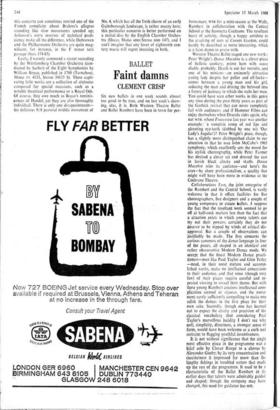Faint damns
BALLET CLEMENT CRISP
Six new ballets in one week sounds almost too good to be true, and on last week's show- ing, alas, it is. Both Western Theatre Ballet and Ballet Rambert have been in town for per- formances; will for a mini-season at the Wells, Rambert in collaboration with the Central School at the Jeannetta Cochrane. The resultant burst of activity, though a happy antidote to the cracking of nuts at Covent Garden, could hardly be described as more interesting, which is a faint damn to praise with.
Western Theatre Ballet staged one new work: Peter Wright's Danse Macabre is.a clever piece of balletic cookery, prime ham with sauce diable, probably. Death is out for recruits, and one of his minions—an eminently attractive yontig lady despite her pallor and elf-locks- comes between a young man and his girl, seducing the man and driving the beloved into a frenzy of jealousy in which she stabs her man.
You could have seen other works in this genre any time during the past thirty years as part of the Gothick revival that can never completely fail with audiences; and if Hammer Films can enjoy themselves when Dracula rides again, why not wrs. whose Francesca last year was another example: 'a vampiric romp of red lips and gleaming eye-teeth (dubbed by one wit 'Our Lady's Jugular')? Peter Wright's piece, though, has a slightly, more distinguished claim to our attention in that he uses John McCabe's 1965 symphony, which excellently sets the mood for his stylish choreography, while Peter Farmer has devised a clever set and dressed the cast in lavish black cloaks and skulls. Danse Macabre wins its audience—and here's the crux—by sheer professionalism, a quality that might well have been more in evidence at the Cochrane Theatre.
Collaborations Two, the joint enterprise of the Rambert and the Central School, is vastly welcome in that it offers facilities for five choreographers, five designers and a couple of young composers to create ballets. I suppose the fact that the, resultant work seemed to go off at half-cock matters less than the fact that a situation exists in which young talents can try out their powers; certainly they do not deserve- to be nipped by winds of critical dis- approval. But a couple of observations can justifiably be made. The first concerns the curious sameness of the dance language in four Of the pieces, all shaped in an identical and rather obscurantist Modern Dance mode. We accept that the finest Modern Dance practi- tioners—men like Paul Taylor and Glen Tetley —need, in their most mature and accomp- lished works, make no intellectual concessions to their audience, and that some (though very few) of their pieces require careful and re- peated viewing to reveal their theme. But with these young Rambert creators intellectual com- plication seemed de rigueur, and the move- ment rarely sufficiently compelling to make one relish the dances in the first place for their own sake. Secondly, though one has learned not to expect the clarity and precision of the classical vocabulary (but considering Paul Taylor's marvellous lucidity I don't see why not), simplicity, directness, a stronger sense of form, would have been welcome as a curb and restraint to flagging youthful inventiveness.
It is not without significance that the single most effective piece in the programme was a bief solo by Clover Roope to a chorus by Alexander Goehr; by its very concentration and succinctness it impressed far more than the Itngthy fishings in troubled waters that made up the rest of the programme. It used to be a characteristic of the Ballet Rambert in its earlier days that talents were admirably guided and shaped; though the company may have changed, this need for guidance has not.










































 Previous page
Previous page